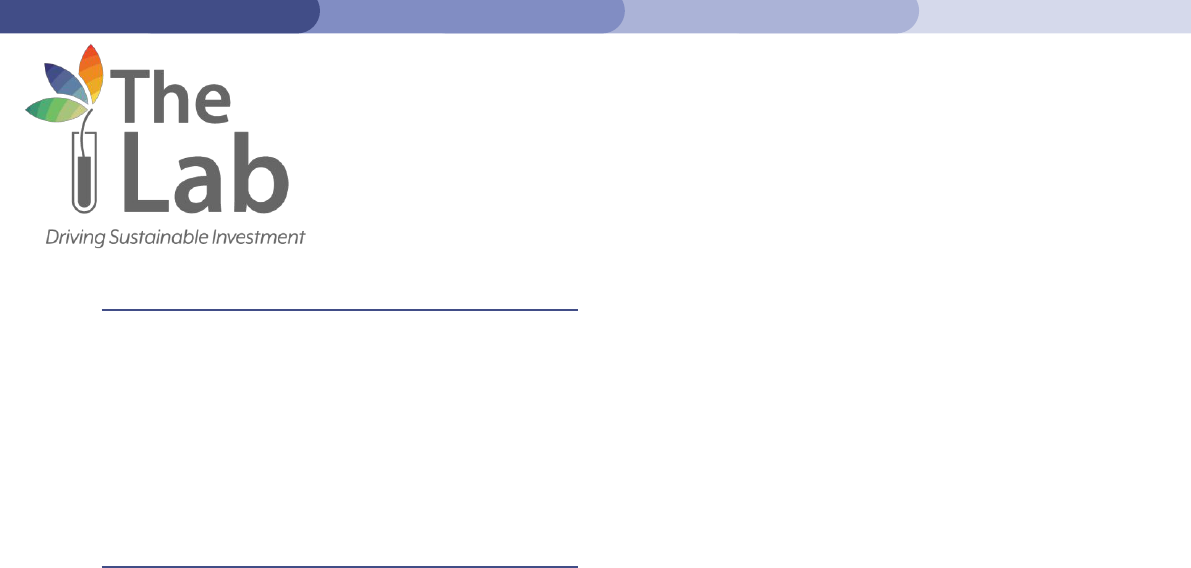
1
Monetizing Water Savings (MWS)
LAB INSTRUMENT ANALYSIS
September 2020
DESCRIPTION & GOAL —
A novel, collaborative approach to improve economic outcomes for farmers, create
resilient supply chains and increase water efficiency by using “pay for performance” to
accelerate sustainable agriculture practices in water-stressed regions.
SECTOR —
Sustainable Agriculture, Water, Nature-Based Solutions
FINANCE TARGET —
Corporations (food and beverage), water utilities and water funds; development finance
and impact investors.
GEOGRAPHY —
For pilot phase: Mexico
In the future: Brazil and the rest of Latin America
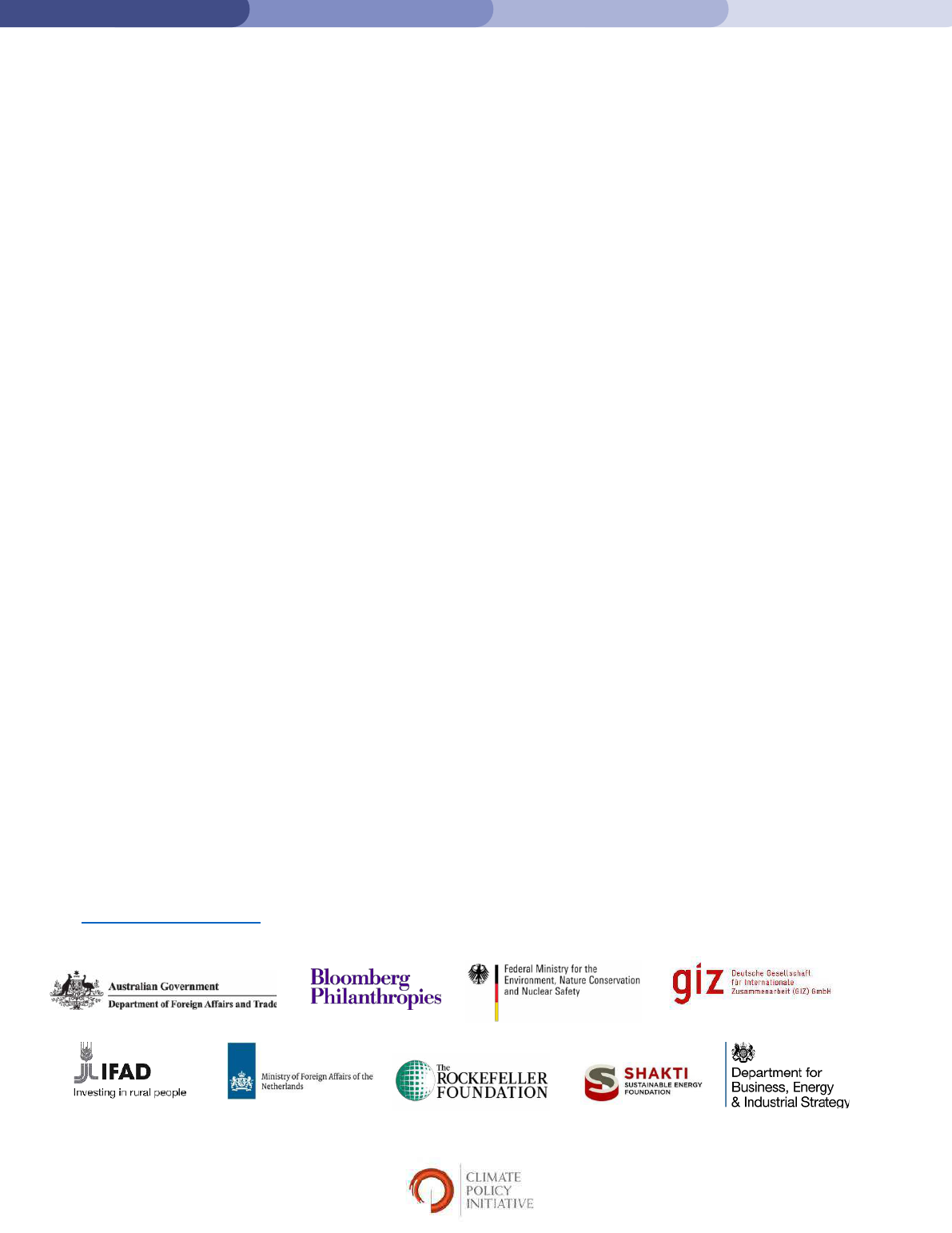
2
The Lab identifies, develops, and launches sustainable finance
instruments that can drive billions to a low-carbon economy.
The 2020 Global Lab cycle targets four specific sectors across
mitigation and adaptation: nature-based solutions; sustainable
agriculture for smallholders in sub-Saharan Africa; sustainable
energy access; and sustainable cities, as well as three regions:
India, Brazil and Southern Africa.
AUTHORS AND ACKNOWLEDGEMENTS
The authors of this brief are Federico Mazza and Matthew Solomon.
The authors would like to acknowledge the following professionals for their cooperation and valued
contributions including the proponents Todd Gartner, Ana Gabriela Morales, Maggie Gonzalez, Laura
Villegas Ortiz (World Resources Institute) and David Moreno (FEMSA Foundation).
The working group members are: Hugo Alberto Contreras and Justus Raepple (The Nature
Conservancy), Steven Baillie (International Finance Corporation), Casey Brown and Alexa Bruce
(University of Massachusetts), Alice Caravani and Angelina Avgeropoulou (UK BEIS), Alejandro Diaz
Loyola (Convergence), Joao Domingo Cicarini Junior (BB Securities), John Dore (Australian
Department for Foreign Affairs and Trade), Emily LeCornu (AECOM), Patricia Martha Narváez García
(Asociación Bancos de México), JP Moscarella (Climate Finance Advisors), Raúl Muñoz, Larissa Denea
Trejo Carcamo, Keisuke Sasaki, Ricardo Sandoval Minero and Pedro Moreo Mir (Inter-American
Development Bank), Eduardo Ovejas and Isaac Martinez (RRG Solutions Mexico), Eduardo Piqueiro
and Alba Aguilar Priego (CCFV), Everardo Esquivel (FEMSA Foundation) and Angelique Pouponneau
(SeyCCAT). The authors would like to acknowledge the contribution of the experts: Jake Davis
(NatureVest), Vincent Lagace and Maria Luisa Luque (Nuup), Thomas Legrand (independent
consultant) and Gabriel Thoumi (Planet Tracker). Special thanks to Albert Amos (former-World
Resources Institute).
The authors would also like to thank Ben Broche, Barbara Buchner, Elysha Davila, Ricardo Narvaez,
Daniela Chiriac, Leigh Madeira, Valerio Micale, Rob Kahn, and Júlio Lubianco
for their continuous
advice, support, comments, design, and internal review.
The Lab’s 2019/2020 programs have been funded by the Australian, Dutch, German, and UK
governments, as well as Bloomberg Philanthropies, GIZ, the International Fund for Agricultural
Development (IFAD), the Rockefeller Foundation, and the Shakti Sustainable Energy Foundation.
Climate Policy Initiative (CPI) serves as Secretariat and analytical provider.

3
SUMMARY
Climate change is worsening water scarcity issues around the world. Agriculture irrigation
accounts for 70% of freshwater consumption globally. Intensive groundwater pumping
depletes aquifers, affecting urban water supply and food production, while increasing the
vulnerability of smallholder rural farmers in arid and semi-arid areas.
Improving agricultural irrigation practices has enormous potential to address water crises,
but farmers in developing and emerging countries often lack the right resources, business
models to participate in, or incentives to implement them.
Monetizing Water Savings (MWS) aims to provide smallholder agricultural producers, who
otherwise do not have access to financing to implement sustainable solutions, with the
necessary incentives and resources to increase their productivity without bearing high levels
of financial risk, while increasing water efficiency, improving soil quality and increasing the
climate resilience of already water-stressed regions.
This instrument meets all four of the Lab endorsement criteria and the Secretariat therefore
recommends for endorsement:
Innovative:
MWS is a novel approach to coordinating the efforts of government, corporate
and agricultural actors to address agricultural water inefficiencies in highly water-stressed
regions of emerging economies. Its specific combination of factors has not previously been
seen in the water sector in a developing country.
Financially Sustainable:
With the creation of two revenue streams (from producers and
utilities) and a corporate partner committed to purchasing the agriculural products, MWS is
expected to become commercially viable and sustain a significant level of capital and
technical assistance for implementing sustainable agriculture improvements that contribute
to reducting regional water deficits.
Catalytic:
The proposed pilot transaction in the highly water-stressed region of Guanajuato,
Mexico, is expected to serve 4,000 smallholder farmers over approximately 20,000 hectares,
contributing to increase farmers’ yields by approximately 30%, while reducing water
consumption by 3,500 cubic meters per hectare per year. Once proven, the model can be
replicated in other arid and semi-arid agricultural hotspots around the world. The instrument
can generate economic, environmental, and social returns amidst COVID-19, making it a
viable instrument for green recovery.
Actionable:
The combined existence of an experienced proponent providing agricultural,
financial, and water management expertise, a pilot site, and a private sector corporate
partner who is sponsoring feasibility studies are key elements for implementation, although
additional steps are required to secure farmer interest and confirm the logistics of the
instrument. Further analysis into the details of monetization, metrics development and
legal arrangements are being taken to secure the participation of water utilities, which is
a critical component for actionability.
-
Next steps: FEMSA Foundation, WRI and their partners are currently developing a pilot
transaction and finalizing feasibility studies, impact metrics and causality links to develop a
model to monetize farmers’ water savings by incorporating local utilities. As the project
evolves, additional financing will be necessary to meet the intended scale to serve
thousand of farmers and untap the full potential of nature-based solutions beyond the
farmed lands. All of these steps would benefit from the Lab endorsement.

4
TABLE OF CONTENTS
SUMMARY .......................................................................................................................................... 3
CONTEXT ............................................................................................................................................ 5
CONCEPT .......................................................................................................................................... 6
1. Instrument Mechanics ........................................................................................................... 6
Key Stakeholders .................................................................................................................... 8
NBS and technification solutions ........................................................................................ 10
2. Innovation ............................................................................................................................ 11
Barriers Addressed: Providing Farmers Tools to Increase Water Efficiency and Yields ... 11
Innovation: Monetizing water savings ................................................................................ 12
Challenges to Instrument Success ...................................................................................... 13
MARKET TEST AND BEYOND ............................................................................................................ 15
3. Implementation Pathway and Replication ....................................................................... 15
Pilot project in Guanajuato, Mexico .................................................................................. 15
Implementation Pathway ................................................................................................... 16
Pilot implementation challenges ........................................................................................ 17
4. Financial Impact and Sustainability ................................................................................... 19
Quantitative Modeling ........................................................................................................ 19
Replication Potential ........................................................................................................... 20
5. Environmental and Socio-economic Impact .................................................................... 21
Environmental Impact ......................................................................................................... 21
Social and Economic impact ............................................................................................. 22
Sectoral Impact: Nature-Based Solutions .......................................................................... 22
NEXT STEPS ....................................................................................................................................... 23
REFERENCES .................................................................................................................................... 24
Annex I: Scenarios regarding water availability and sources ..................................................... 26
Annex II: Examples of comparable instruments ........................................................................... 27
Annex III: Financial Modelling Details ............................................................................................ 28

5
CONTEXT
Irrigated agriculture is the single largest source of water consumption worldwide.
Improving irrigation efficiencies can greatly contribute to addressing water crises
exacerbated by climate change.
Agriculture irrigation accounts for 70% of freshwater consumption globally (FAO, 2020).
Intensive groundwater irrigation pumping to support inefficient agricultural practices not
only depletes aquifers but is expensive and can expose consumers to unsafe water. In many
parts of the world, regulating the excessive use of groundwater is often impeded by political
considerations. Floods and droughts are also intensifying due to land degradation, poor
environmental management and climate change, making it increasingly critical to manage
water resources and build overall hydrological resilience.
Improving water management in the agricultural sector has enormous potential to address
water-related crises while improving the stability and profitability of agribusiness and
connected value chains. However, despite the obvious benefits, smallholder farmers in
developing countries often lack the access to financing, correct incentives and technical
know-how to implement improvements.
The Monetizing Water Savings (MWS) instrument provides agricultural producers with the
necessary tools to become more productive while significantly reducing their water
consumption. These solutions improve the resilience and reduce the water deficit of already
water-stressed agricultural-intense regions, contributing to the business continuity and
profitability of producers themselves, the supply chains of related large corporate buyers,
local water utilities and governments, and ultimately household consumers in nearby cities.
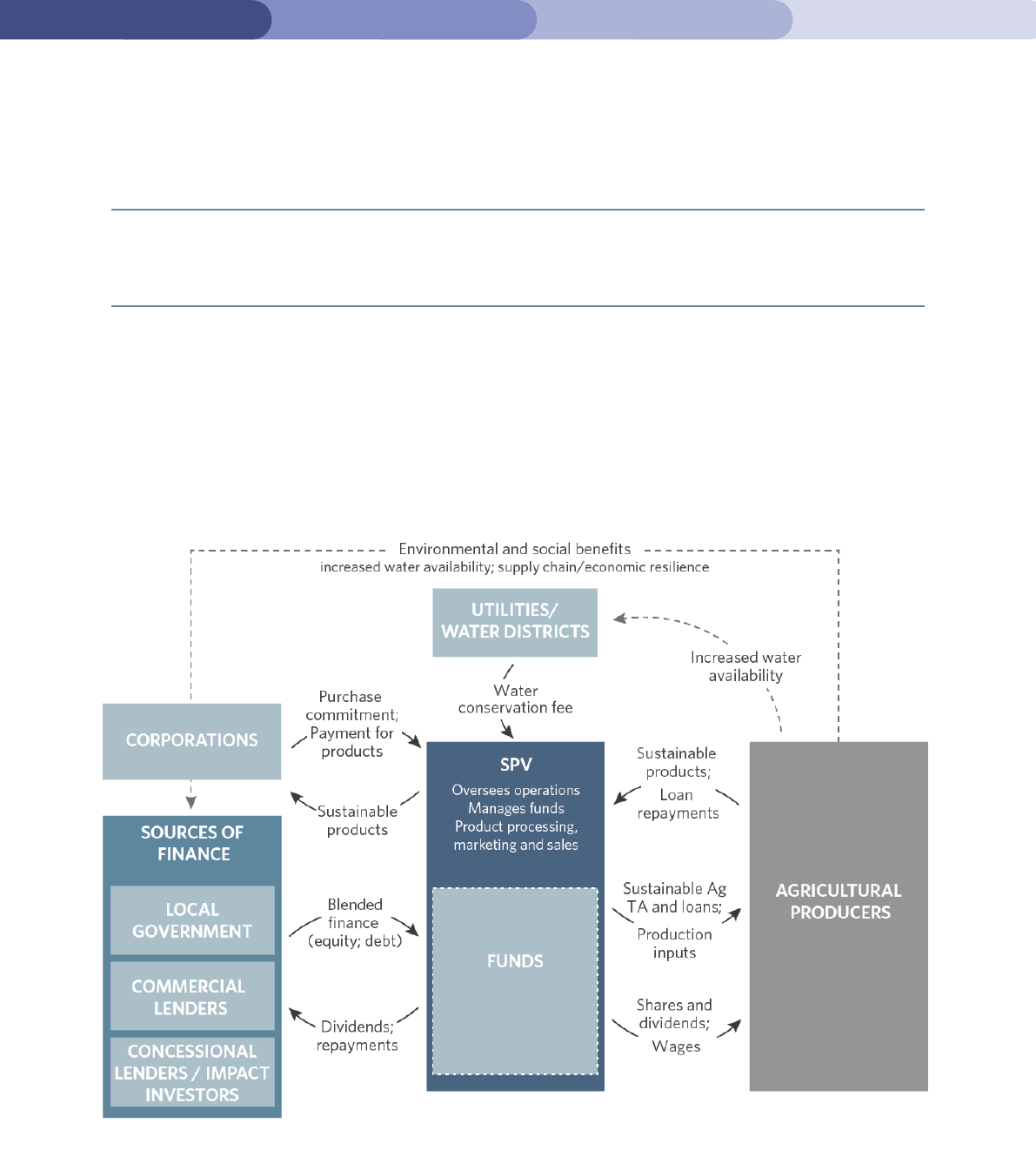
6
CONCEPT
1. INSTRUMENT MECHANICS
MWS will improve water conservation and economic outcomes of agricultural
producers by providing financial and technical resources to expand sustainable
agriculture practices.
Proposed to the Lab by the World Resources Institute (WRI) and the FEMSA Foundation, MWS
is a multi-stakeholder approach to increase sustainable water usage in the agricultural
sector of emerging countries, while improving economic outcomes for agricultural
producers and the resilience of related supply chains. Figure 1 illustrates the key actors and
financial flows.
Figure 1. Instrument mechanics
MWS will be set up as a Special Purpose Vehicle (SPV), responsible for aggregating multiple
agricultural producers and facilitating and monitoring the adoption of new equipment and
practices, that will increase farmers’ productivity while significantly reducing their water use
and associated costs. These practices include the implementation of Nature-Based Solutions
(NBS), such as conservation agriculture, riparian buffer strips, or cover crops, along with
technification and other water efficiency measures, and will be tailored to characteristics of
the specific country or region targeted.

7
An overarching committee formed of representatives from the different groups of
stakeholders involved (including an anchor corporation, technical water management
experts, individual producers and cooperatives, local NGOs, public sector and financial
partners) will i) set up the SPV, ii) identify the optimal locations for implementation, iii)
oversee and coordinate operations (including the screening and monitoring of producers),
iii) aggregate, process and sell the product, and iv) allocate funds to farmers and collect
repayments.
A corporate partner helps to secure the demand of crops produced by farmers through a
purchase commitment signed with the SPV, which aggregates and processes the crops
produced by the individual farmers, organized under a newly established cooperative
association. This approach enables the corporation to obtain reliable, sustainable and
resilient sourcing and over time creates a more integrated supply chain.
Funds will be deployed to farmers in three main ways:
• Capital investments, in the form of loans at favorable terms to i) purchase modern and
efficient irrigation systems, ii) introduce conservation agriculture practices, including NBS.
The financing terms are targeted at farmers that might not otherwise have access to
financing at all, offering favorable combinations of term length and interest rates as
compared to the financing options normally available. Loan terms may vary based on
the extent of conservation agreed by the farmers: for example, interest rates decrease
as farmers implement supplementary measures and environmental practices to increase
their water efficiency. In exchange for the favorable loan terms, producers agree to sell
their products to the SPV and accept its water monitoring requirements.
Depending on the farmers’ preferences and the on-the-ground conditions, there may
be an option for the farmers to become equity shareholders in the SPV, in addition to
receiving loans.
• Technical expertise, offered before, during, and after the loan agreement.
Pre-financing: MWS’ experts identify what practices bring the highest gains to individual
farmers in terms of productivity, cost reduction and water savings and work with them to
develop a tailored financing plan. MWS’ water management and financing experts will
determine what the optimal strategy will be in terms of reducing the water deficit and
how to best structure agreements between the farmers and the SPV. These initial
assessments will also explore what NBS can be implemented and the potential for
switching to higher value crops.
During the whole financing cycle: MWS will continue to assist farmers throughout the
financing cycle, helping them to implement and maintain new equipment and
practices, expand market access, monitor water usage, and track savings. As part of its
capacity building activities, MWS will develop a longer-term commercial strategy with
farmers and formalize their role in the supply chain of the anchor corporate partner.
• Production inputs, like seeds, fertilizers and wages.

8
Along with the sale of products to the corporate, once operational the model unlocks two
additional revenue streams:
1. Repayments of farmer loans through increased crop revenues, reduced costs and
improved access to markets.
2. Monetization of systemic water savings, from water utilities or other public institutions
through a water conservation fee paid to the SPV and calculated with a “pay for
performance” approach. The SPV will be responsible for monitoring water savings and
will work with a third-party entity that will independently audit these water savings on
a regular basis.
Upfront capital to set up and scale the model will come from different investor classes,
ideally as a blended mix of equity and debt from development finance institutions, local
governments and agencies, impact and commercial investors, and corporate partners.
KEY STAKEHOLDERS
An initial pilot of this mechanism is currently being developed in the state of Guanajuato,
Mexico with a specific focus on improving water efficiency for local production of grains
(more in Section 3.1). The model can be replicated in other countries where similar
conditions exist and key stakeholders are mobilized to implement it. Below is a summary of
the stakeholder types in MWS and the benefits they receive from participation in the
scheme.
Anchor corporate partner: The corporate partner will contractually agree to buy crops
produced by farmers participating in the instrument, simplifying and further integrating the
supply chain, thus reducing the company’s uncertainty and the risk of participating farmers.
The ideal corporate partner is a large food or beverage company, willing to pay a price to
improve their water efficiency of its suppliers in order to safeguard its operations from current
and projected water scarcity, as well as to create a more sustainable, integrated and
resilient supply chain strategy. In addition, the corporate partner could receive value from
the model by providing upfront funding and participating as an equity investor.
The FEMSA
1
Foundation will be the main corporate partner in the pilot project, and is
coordinating with the technical advisors to develop a technical and financial strategy to
ensure a financially viable, environmentally sustainable and socially equitable project.
Water management experts and technical advisors: These technical advisors will play a key
role in laying the analytical foundation to generate the desired impact in terms of reducing
the water deficit and creating positive economic outcomes.
FEMSA Foundation has strategically established a partnership for the pilot stage with the
World Resources Institute; RRG Solutions Mexico, a sustainability-focused private equity firm;
University of Massachusetts; and Rieggo
2
, an irrigation solutions organization. RRG Solutions
Mexico, WRI, and the University of Massachusetts are contributing financial, hydrological
systems, and regional analysis required to choose a pilot site, construct the instrument, and
1
FEMSA Foundation works to positively impact people and communities through social investment for sustainability. It focuses
on three strategic areas: i) promote the efficient management of resources for sustainable development, ii) foster a
comprehensive development for early childhood and iii) disseminate Latin American art and culture. FEMSA Foundation
contributes to the creation of social and environmental value of FEMSA, a listed multinational beverage and consumer
products company based in Monterrey, Mexico with over 300,000 employees in 13 countries. For more information:
www.femsafoundation.org
2
https://rieggo.com/

9
model impacts. It is conducting the initial assessment of water availability, potential savings,
and value of such savings in the pilot project region. Rieggo will provide support for
implementing the technification solutions.
Public sector partner (water utilities, state governments, water districts, municipalities): Public
sector entities have similar interests in reducing water overconsumption from agricultural
producers but lack the jurisdiction and resources to address the underlying issues that have
caused it. For example, inadequate pricing of water and electricity for pumping, or
unsustainable allocation of water extraction rights are a major concern for many public
sector entities. At the same time, growing urban centers in many parts of the world often
face water shortages and need to identify alternative water sources, especially as they
prepare for the increasing potential of drought conditions.
Technical efficiencies introduced by the MWS will reduce the water needs of participating
farmers, easing the pressure on the local surface and groundwater resources. If properly
monitored, a portion of this water savings may be transferred for use by water utilities in
nearby urban centers that rely on unsustainably over-tapped aquifers, partially relieving the
urban water deficit and potentially even reduce the cost to implement more expensive
water infrastructure solutions. In exchange for these benefits, public sector institutions will pay
a “conservation fee” to MWS.
Civil society organizations: CSOs will be vital in implementing MWS through local
relationships, expertise in introducing and maintaining sustainable practices, and assistance
in formalizing farmer interactions.
Several CSOs are currently partnering with the proponents to design the pilot project:
• Nuup
3
, a Mexican non-profit organization, will conduct market research, contribute to
the design and inform high-level strategy, and facilitate stakeholder dialogue.
• A platform to aggregate farmer financing such that farmers are shareholders in the SPV
and payments and communications are simplified will be based on similar initiatives from
Grupo Paisano
4
, a multidisciplinary fair trade company focused on smallholder
producers.
• Water funds, such as the newly established water fund in Guanajuato named Cauce
Bajío
5
, will assist with governance and supervision of the fund.
Farmers: MWS initially targets smallholder farmers (< 5 hectares) who use inefficient irrigation
practices and systems and who may or may not be the owners of the land they cultivate.
Many of these farmers do not have access to longer-term financing and technical
assistance to upgrade their irrigation practices. In order to scale quickly and reach as many
farmers as possible, MWS will contract a specialized company to create a new cooperative
or association to aggregate the farmers and manage their products and cashflows. Through
the cooperative, farmers will sell their products directly to the corporate end-buyer,
bypassing various intermediaries that reduce their share of revenues.
Independent impact evaluator: A third-party independent organization will be necessary
and tasked with: (i) conducting the initial assessment of water availability, potential savings
and value of such savings in the region, and (ii) monitoring and measuring the realized
impacts. As part of the initial feasibility assessment, the University of Massachusetts is currently
running a hydrological and water resilience study on water flows in the pilot area in Mexico,
3
https://nuup.co/
4
http://www.grupopaisano.com/
5
https://www.burocreativo.com/femsa/

10
water efficiency interventions on groundwater recharge, and economic outcomes for
farmers which will act as the baseline for the independent impact evaluation.
NBS AND TECHNIFICATION SOLUTIONS
The MWS aims to increase farmers’ efficiency, while generating water savings, through
sustainable agriculture practices, including two main types of activities: technification and
NBS
6
.
Technification: The model primarily supports the purchase, installation and maintenance
costs of modern irrigation systems (e.g., automated drip irrigation), which allow for more
efficient use of water and targeted use of fertilizers and pesticides, the single main cost for
most farmers. Energy costs will also decrease, as farmers will reduce the extraction of
groundwater through diesel-powered well pumps. MWS will also invest in a monitoring
system, as this will be a critical component to ensuring compliance with the model.
Other practices for sustainable water conservation may be funded, including systems for
rainwater harvesting, water reservoirs, irrigation land levelling and farmer’s digitalization. Well
perforation and groundwater pumping equipment will not be funded, since one of the goals
of the instrument is to reduce groundwater extractions.
Nature-Based Solutions: One key condition for farmers to access the MWS financing solutions
is the adoption of conservation agriculture (CA) practices. CA is a sustainable farming
approach based on three principles: crop diversification, minimal soil movement and
permanent soil cover. The benefits are widespread, as CA conserves natural resources,
biodiversity, and labor, while improving long-term soil quality, water retention and drought
resilience (CIMMYT, 2020).
Depending on field location, soil type and farmer preferences, the MWS team will work
closely with farmers to introduce additional NBS that have potential to further improve the
soil quality and add benefits for biodiversity and climate resilience. Some of these solutions
may eventually unlock new income streams for the farmers. Examples of these practices
could include different forestry and agroforestry solutions, like alley-cropping (potentially
with high commercial value trees), filter strips with native vegetation or conversion of field
hedges to sown pollinator areas.
Beyond the farm level, MWS will leverage connections with municipal and state
governments to introduce “landscape improvements” (when applicable), restoring
degraded and unused lands of public domain.
Crop switching: In parallel to the previous two categories, MWS will also work with farmers to
explore the possibility of diversifying their current production and switching to different crops
that have higher value and are more water efficient. This change will require a broader set
of solutions, from irrigation equipment, to provision of expertise and practices, to different
transportation and selling arrangements for the new produce.
In order to bolster the successful implementation of all the sustainable practices, MWS will
provide long-term capacity building to farmers in other related areas such as strategy
development, formalization of the purchase contract with the corporate partner, and
assistance with the payment mechanisms.
6
Nature-based solutions are defined by IUCN as “actions to protect, sustainably manage, and restore natural or modified
ecosystems, that address societal challenges effectively and adaptively, simultaneously providing human well-being and
biodiversity benefits” (IUCN, 2020).
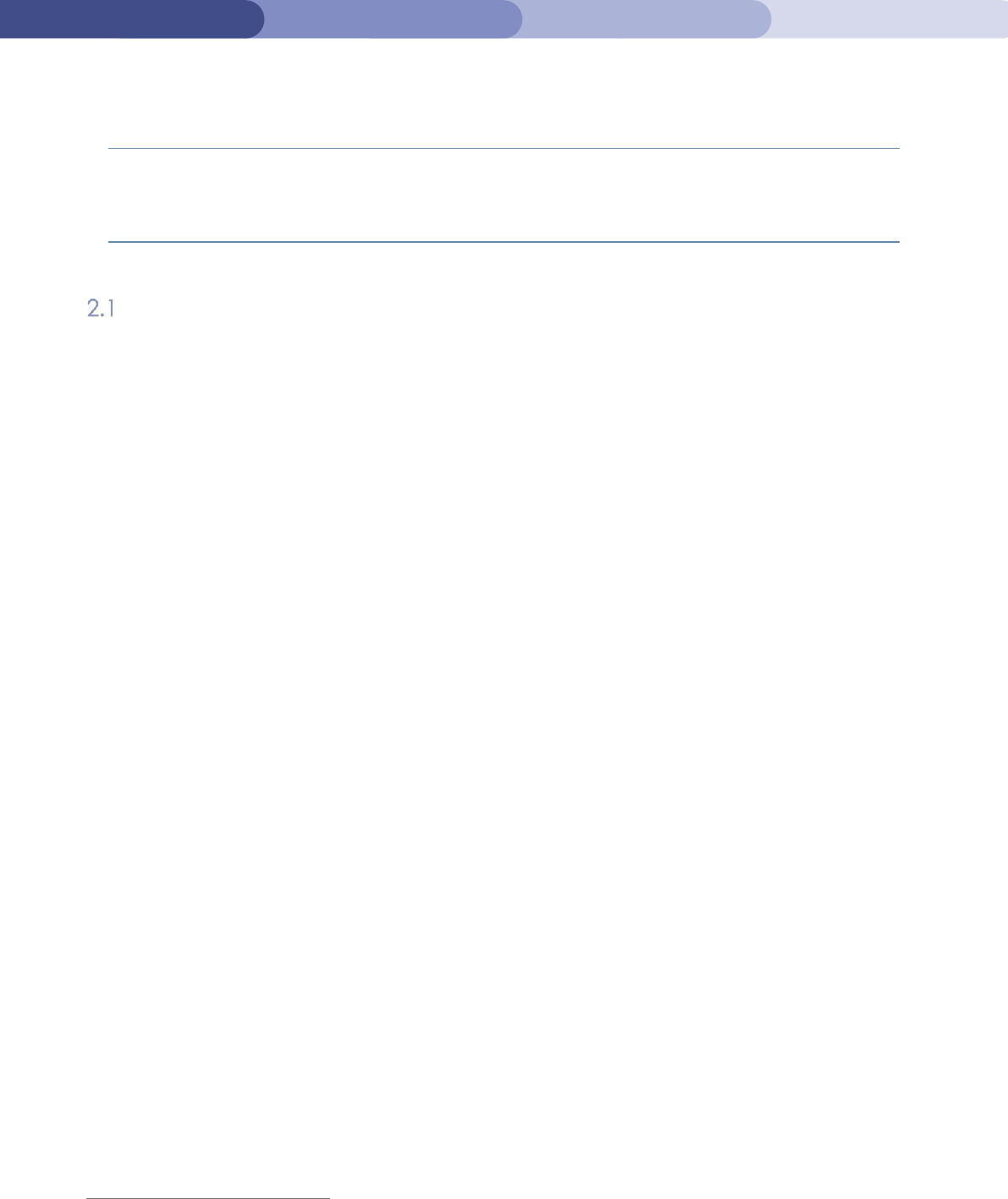
11
2. INNOVATION
For the first time in an emerging country’s water sector, MWS will monetize the benefits
that corporates, water utilities and other stakeholders may accrue from increased
long-term water security and availability.
BARRIERS ADDRESSED: PROVIDING FARMERS TOOLS TO INCREASE WATER
EFFICIENCY AND YIELDS
The instrument addresses key barriers that are preventing agricultural producers in water-
stressed areas from investing in sustainable agriculture practices and water efficient
technologies.
Barrier: water efficiency is not effectively tracked and paid for by beneficiaries. In Mexico,
many water meters are either uninstalled or do not function properly (Hoogesteger and
Wester, 2017), and there is limited state capacity to offer a solution. Since there is no
mechanism for utilities or other beneficiaries of water savings to receive or pay for these
efficiencies, there is limited financial incentive to institute solutions.
Response: MWS partners with utilities to monetize water efficiency, ensuring a monetary
benefit of increased monitoring and verification. MWS will develop a monitoring and
evaluation plan with which smallholders are required to comply to access loans and other
support.
Barrier: limited incentives for farmers to implement water efficient practices. In many
countries, the cost of water and electricity for pumping groundwater
7
are often subsidized,
representing only a minor component of farmers’ expenses. In addition, when multiple
farmers extract water from a communal well, investment in water efficiency may be
jeopardized by the collective action problem in which neighboring farmers that have not
adopted sustainable practices will benefit from increased water availability without making
similar investments. Therefore, investments into water efficiency are not considered by
smallholders as a priority to save money or increase sustainability in the system, even as they
recognize the broader regional water crisis.
Response: MWS will focus on improving farmers’ economic outcomes by increasing yields
and profits, as well as reducing the associated costs of adopting modern irrigation systems
(e.g., fertilizers
8
and labor) that simultaneously generate significant water savings and create
the appropriate incentives for farmers to collectively adopt these types of practices.
Barrier: lack of awareness and financing solutions to implement sustainable agriculture and
NBS best practices. Public and private investment into sustainable agriculture remains small
in emerging countries, with local entities often lacking the necessary technical awareness
9
to implement them successfully. In Mexico, access to financial resources for climate smart
agriculture is a major challenge, as only 1.5% of finance products are channeled to the rural
sector. Farmers often struggle to access finance products because this financing is not
7
In Mexico, agricultural consumers pay the lowest electricity prices among all consumers. This disincentive encourages
elecricity consumption to pump up water from underground wells.
8
Fertigation is the application of fertilizers with irrigation water. Its efficiency can be maximized with modern systems, leading to
significant cost savings for the farmers.
9
In Mexico, for example, less than a third of agricultural producers apply fertilizer based on soil analysis (World Bank; CIAT;
CATIE. 2014). Some farmers also appear not to know precisely the size of their fields, which means calculations about the
necessary irrigation levels are very inaccurate (Löffler-Dauth, 2017).

12
aligned with farmers’ productive conditions (World Bank; CIAT; CATIE. 2014).
Response: MWS will provide financing at competitive terms to purchase modern irrigation
systems and introduce conservation agriculture practices, for smallholders to which
commercial financial institutions would otherwise not lend. Depending on the land
conditions, there might be a possibility for the farmer to achieve lower financing rates by
opting in to installing and maintaining NBS that result in greater long-term environmental
benefits. MWS will also provide initial and ongoing technical assistance and training to de-
risk these operations and increase the reliability of repayment.
Barrier:
Farmers generally operate individually and must rely on intermediaries, lowering their
profits and increasing supply chain complexity and costs for corporate partners. Variance in
farmer professionalization further increases costs and uncertainty for all stakeholders.
Response: MWS will work with local civil society organizations with pre-existing farmer
relationships to establish an internal cooperative structure to aggregate farmers and their
products. This cooperative structure will allow farmers to gain a preferential selling channel
for their products, ensure cooperation and monitoring of water savings, and depending on
the region and the farmers’ preferences, they could join the SPV as shareholders. Corporate
partners will benefit too as they will sign long-term supply contracts and interact with a
centralized group of dedicated suppliers, on top of the environmental and social
responsibility benefits.
INNOVATION: MONETIZING WATER SAVINGS
At the heart of MWS is the concept of monetizing the benefits of water efficiency practices
and NBS. MWS is unique because it not only has in-house expertise and technical
knowledge, but it partners both with a corporation to incentivize farmer involvement, and
with a water utility or governmental entity to capture the benefits of increased water
availability to the entire water system through a “conservation fee”. While these concepts
have been used in the water sector in the US and other developed countries in a few
different projects, they have not yet been developed in Latin America.
Water efficiency practices and NBS at the farm level can increase the overall availability
and sustainability of water in the region. In theory, a portion of the “additional” water in the
system from sustainable sources can be transferred to water utilities in nearby urban centers
that are otherwise relying on unsustainable sources. MWS can therefore contribute to easing
the pressure on overexploited local water sources in the rural and urban sectors and
reducing the local water deficit. Depending on the biophysical conditions and regulatory
environment, this net benefit can be achieved in different ways, and the specific
transaction structure will depend on the unique set of conditions. Four scenarios are
presented in Annex I.
In order to properly align incentives and share risks for the SPV, the water utility, and other
investors and off-takers, the “conservation” payments from the utility to the SPV should be
based on the instrument’s ability to meet certain criteria, whether that is, for example, cubic
meters of water saved or farmers serviced:
• If MWS does not meet this threshold, the utilities do not get the benefits of water
savings and will pay a lower amount to the SPV. In this case, utilities are forced to
acquire water from more unsustainable sources and in some instances spend more
on grey infrastructure, charging those costs to consumers in the territory.
• If MWS does meet the threshold, then the utilities provide full (or excess) payment to
the SPV, resulting in excess returns to investors. The rate of payment would be
structured such that even when it is higher due to instrument success, the utility still
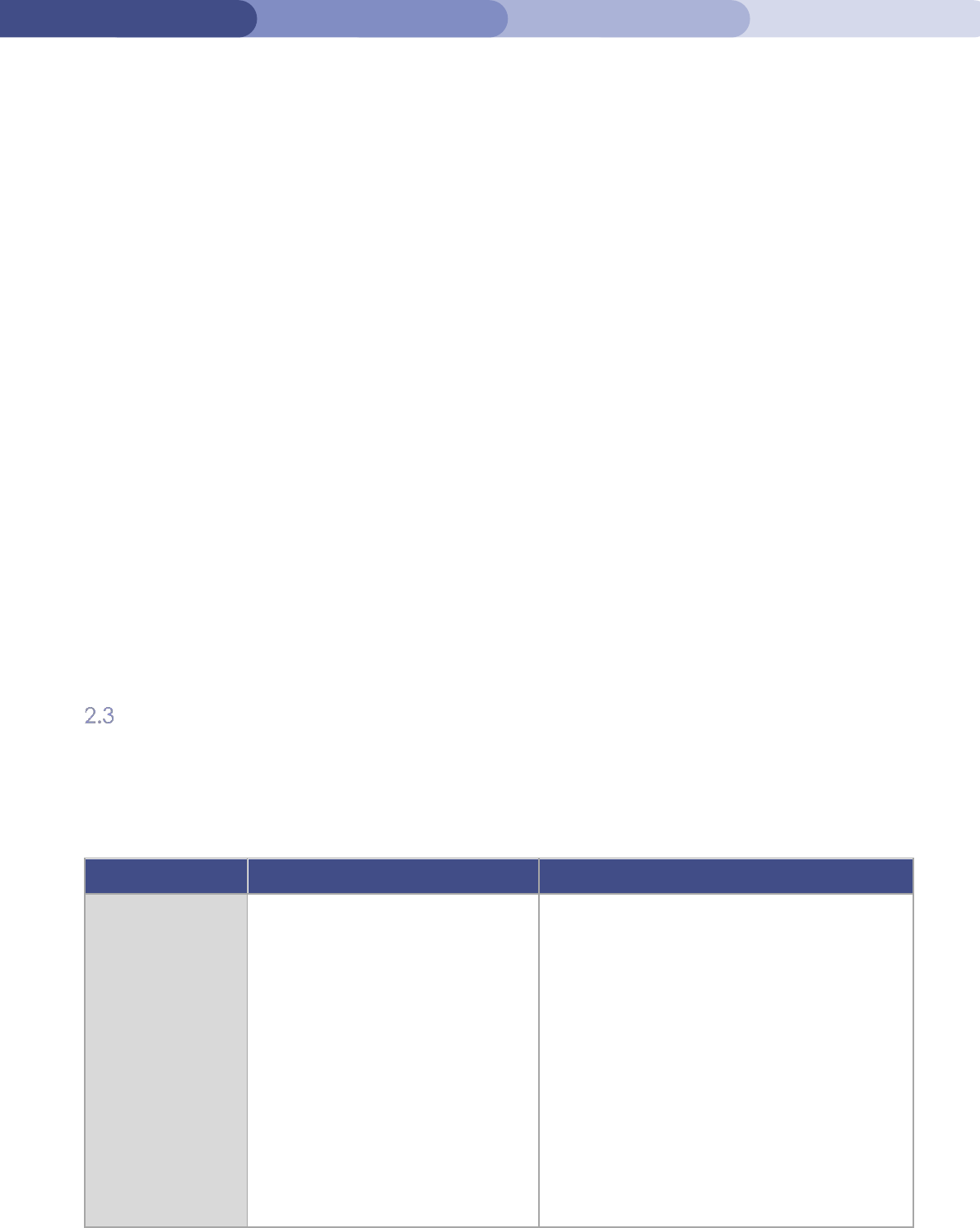
13
benefits because the payment is lower than either the utility’s avoided costs or the
value to the utility of having access to alternative water sources.
As a result, the SPV and the utility are financially incentivized to implement the project as
effectively as possible. This type of scheme is appropriate for the utility (or other public sector
institutions) because the utility has a higher ability to bear risk than a smallholder farmer and
has substantial upside benefits from effective implementation.
Calculating the most appropriate conservation fee, can be done with two approaches:
“pay for success” and “pay for performance.” The best approach depends on ease of
monitoring, risk appetite, and ability to connect actions to end outcomes. Examples of
comparable PFS and PFP instruments are provided in Annex II.
• In a pay for performance (PFP) arrangement, the utility would pay the SPV a set
amount based on an easily trackable and relevant metric, such as number of farmers
who received drip irrigation systems or who switched crops. PFP does not require as
extensive modelling or monitoring of water flows, but payments will be less accurately
tied to real-world outcomes. This option is more likely to be implemented in the
current MWS framework due to its relative simplicity and low cost of implementation.
• Under a pay for success (PFS) model, the utility would pay the SPV based on the
exact amount of farmers’ water reduction. This arrangement rewards actors for
tangible beneficial outcomes, such as cubic meters of increased water availability,
but comes with higher administrative and analytical costs. Comparable examples of
PFS instruments in the water sector are primarily in the US, Europe, and the Middle
East, and this type of instrument has not been developed extensively in developing
countries.
CHALLENGES TO INSTRUMENT SUCCESS
To increase the probability of its success, the Lab Secretariat has thoroughly analyzed
potential challenges to implementation (Table 1), along with the strategies to address them
that the proponents will incorporate into the design and operational practices of MWS.
Table 1. MWS challenges and response
Challenge
Description
Response
Low adoption rate
from farmers
Due to historical and cultural ties
to established farming practices,
rural communities may be
reluctant to adopt changes that
MWS proposes (in particular,
farmers that do not own the land
may be unwilling to invest in long-
term practice improvement)/.
MWS will focus on increasing farmers yields
as the main incentive to attract farmers.
Additional benefits that generate
immediate cashflow will be also offered,
such as offering a stake in the SPV, providing
labor payments (such as wages or service
contracts), and guaranteeing the purchase
of produce. MWS will also promote longer
term rental contracts or provide low-cost
long-term loans for farmers to acquire the
land they farm.
The newly built cooperative will be tasked
with outreach to and coordination of
farmers.

14
Farmers
defaulting on
loans
Many factors may cause farmers
to underperform, resulting in an
inability to repay the loans,
including i) risk of new crops
failing, ii) variable crop yields
based on drought conditions, and
iii) farmer selection process
To reduce risks for farmers and the SPV, loans
will cover up to 90% of the cost of the
irrigation system, and the loan terms will be
structured in a way that simplifies the
repayment (aligning them with the farmers’
production conditions and liquidity cycles).
The anchor corporate partner will sign long-
term purchase agreements, securing a
source of income for the smallholders which
helps the loan repayment.
Other risk mitigation strategies like drought
insurance, first-loss funds, and additional
guarantees to de-risk the model especially
throughout its early stages are being
explored to further reduce the risks of the
SPV.
Failed
conversion of
improvements
into
environmental
and water
benefits
Despite the adoption of water-
efficient practices, farmers may
fail to fully or consistently comply.
For instance, by continuing to use
flood irrigation and pumping of
groundwater beyond their
concession. Mismanagement of
the new irrigation systems and
abandonment of NBS may also
hinder the achievement of
environmental and water
benefits.
Farmers involved will agree to follow
monitoring guidelines and respect the water
consumption concessions. The SPV would
penalize farmers who violate the terms, by
increasing interest rates or removing them
from the facility.
MWS will carry out periodic farm visits to
monitor and provide free assistance on
equipment maintenance and NBS
implementation
Enforcement efforts will be coordinated with
local governments, water utilities, regulators
and other stakeholders.
Water savings may be
jeopardized by increased
consumption from other farmers
and industrial players extracting
from the same water source.
The MWS will focus its activities and outreach
efforts around the area served by a specific
water source (a single river or aquifer),
working with as many farmers as possible in
the area.
The corporate partner will also commit to
adopt sustainability practices and not
increase its own water consumption.
The model requires robust metrics
for measuring water savings,
accurate monitoring systems and
attribution methodologies.
Proponents and other stakeholders in the
pilot area of Guanajuato are currently
collecting data to create these
components.
Once completed, the results will inform the
creation of accurate monitoring and
evaluations approaches, with templates
that can be developed and used in other
geographies.

15
MARKET TEST AND BEYOND
3. IMPLEMENTATION PATHWAY AND REPLICATION
An initial pilot transaction is currently being explored in the region of Guanajuato,
Mexico, focused on grains production.
PILOT PROJECT IN GUANAJUATO, MEXICO
WRI, FEMSA Foundation and other partners (RRG Solutions Mexico, Nuup, Grupo Paisano,
Cauce Bajío, and Rieggo) are currently designing a pilot transaction in Guanajuato, a highly
water-stressed region in Mexico.
10
In Guanajuato, approximately 84% of water rights allocated are for agriculture, 13% is for
drinking and general water consumption, and 3% for industrial uses (GTO Water Commission,
2017). As a result of huge growth in agricultural production and ground water wells
(Maranon, 2000), ground water levels in Guanajuato are decreasing by approximately two
meters per year (GTO, 2015). Moreover, due to poor water retention practices, leaky
infrastructure and highly inefficient irrigation practices, water losses in the account for of up
to 60% of the water used, potentially reducing
water access for local agricultural producers,
industrial users, and nearby cities (SDAYR-GTO, 2013). The most common irrigation method in
the state of Guanajuato, as in the rest of the country, is flood irrigation
11
, which is the lowest-
cost method, but also the least efficient (SIAP 2018; Lopez-Morales 2011).
Given MWS’s overarching goal of reducing the region’s water deficit, additional studies such
as those being developed by UMass, will have to be conducted for each aquifer to assess
whether a portion of the “water losses” (i.e., irrigation water not consumed by crops) are
currently contributing to recharging the aquifer. These studies will also incorporate the
impact of NBS on water filtration and water system sustainability, and only NBS that have a
positive overall impact will be suggested and implemented.
In one of the target irrigation areas for this pilot
12
, near the La Purisima dam and the second
largest city in Guanajuato (Irapuato), the farmers and urban users have different water
sources. Irapuato relies on groundwater extractions from the Irapuato-Valle aquifer, which is
severely water-stressed: the annual water deficit is 71.5 million cubic meters, and further
extraction is increasingly costly and taps more polluted sources (CONAGUA, 2018). The
farmers use water from the La Purisima dam, which contains adequate or surplus volume for
users in the area. While in the short term it might be cheaper for the utility to continue to
extract water from the Irapuato-Valle aquifer, the city cannot continue to drill deeper into
this source indefinitely and must find alternative sources but conveying the water savings in
the pilot area to urban centers would require the water utility or the State Government to
invest in transport and treatment infrastructures.
10
According to Aqueduct (WRI, 2020), Guanajuato is the second highest water-stressed region in Mexico (score of 4.94 out 5),
well above the country average (3.86), and Mexico is already ranked the 24th country in the world for baseline water stresses.
11
Also known as surface or furrow irrigation, it is a cheap and low-tech practice still adopted in many less-developed areas,
where farmers flow water down small trenches running through their crops (USGS, 2020).
12
La Purisima is one of the areas being assessed through feasibility studies for the pilot site selection in Guanajuato, and the
exact location will be decided at the conclusion of these studies.

16
The pilot project is centered around grains production in the Alto Rio Lerma Irrigation District
(ARLID), due to the interest of FEMSA Foundation, which sources grains from the region.
Climate change severely threatens grains yields in the region, and for example barley yields
losses are estimated from 3% to 17% (Beverage Daily, 2018).
Figure 2. Map of Guanajuato
IMPLEMENTATION PATHWAY
MWS will be ideally implemented at scale in 2 stages, with a proof of concept in the
planning stages.
Proof of concept: WRI, FEMSA Foundation and other partners have already begun to
analyze the market potential and associated capital costs of a small piece of the pilot
project within the Alto Rio Lerma Irrigation District (ARLID). Depending on the timing of the
technical studies, market sounding activities, and utility participation, the proof of concept
covering an initial 250 hectares will take approximately 1-2 years to implement.
COVID-19 is impacting the feasibility studies on the ground, which include surveying farmers’
interest in such a model.
Stage 1: The next stage will be to expand the pilot project to other places in Guanajuato
where smallholders primarily grow grains
13
, targeting a total of 4,000 farmers across 20,000
hectares. This will take approximately 3 to 5 years during which the model will continue to be
optimized, particularly in two areas: i) calculating a realistic “conservation fee” to monetize
water savings from local water utilities based on the data collected in the previous phase;
and ii) incorporating other types of water security investments beyond the farms (e.g. urban
NBS, green-gray portfolios, landscape improvements and new potential sources of revenue
associated to these distinct environments).
13
While MWS is primarily focused on grains production in this initial design stage, proponents are also considering how to apply
it to higher value crops (such as strawberries).

17
Stage 2: Assuming the Guanajuato pilot is successful, FEMSA Foundation could expand the
model to the rest of Northern Mexico, Brazil and other countries in Central and Latin America
where FEMSA operates and that present similar challenges and enabling conditions (more in
Section 4.2). MWS will leverage the Latin American Water Funds Partnership
14
, a network of
more than 25 water funds operating throughout Latin America, including Mexico, and the
Cities4Forests initiative
15
to expand the project and identify regions in need of and interested
in an alternative approach. These water funds could also provide capital and / or be the
utility beneficiary of water efficiency, depending on the region and structure of the fund.
Further replication: The pilot is dependent on the involvement of corporate partner and
proponent FEMSA Foundation. There are other corporate partners targeting agricultural
producers in various water scarce regions of the world. Given the catalytic and social aims
of this project, the proponents of the project plan to share learnings about the model and its
implementation on a regular basis through dissemination of results and takeaways.
PILOT IMPLEMENTATION CHALLENGES
Implementing the initial pilot and its expansions across the entire State of Guanajuato will
face specific challenges, which the proponents are evaluating to identify the most effective
solutions. The most relevant of these include:
Legal and administrative ambiguities in Mexico water governance: There are governance
challenges related to which regulatory body is ultimately responsible for different
administrative capacities (monitoring water usage, investing in solutions, etc.). Coordination
challenges may arise between the relevant bodies involved and acquiring government
signoff for budget allocations can be a time-intensive process. FEMSA Foundation and WRI
are experienced working with the authorities in this region of Mexico and are already
partnering with local organizations who can help manage these relationships and identify
solutions that do not require governance changes.
Transfer of water rights: in order to share the systemic water benefits introduced by MWS with
urban centers, water should ideally be both physically and legally allowed to be transferred
between different users. Under Mexican water law, it is technically permissible for users to
transfer to municipalities or water utilities a portion of the water consumption rights allocated
to them by their irrigation districts. However, if the whole irrigation district consistently
underuses its allocation for two consecutive years, farmers may fully lose or get a reduction
of their granted volumes unless they pay a guarantee quota to CONAGUA.
Based on early consultations with experts, MWS could potentially compensate farmers or the
irrigation district for the unused water rights and therefore maintain the allocated quota
when actual water consumption falls below the allocation. Further research and
consultation with lawyers are required to understand whether this will hinder MWS’
development. Even without the ability to transfer water allocations to urban users, MWS will
still generate net positive economic value due to the increase in farmer revenues, the
benefits to the corporate partner, and the environmental benefits.
14
A coalition launched in 2011 between the Inter-American Development Bank (IDB), FEMSA Foundation, the Global
Environment Facility (GEF), the International Climate Initiative (IKI), and The Nature Conservancy (TNC) to contribute to water
security in Latin America and the Caribbean through the creation and expansion of Water Funds.
https://www.fondosdeagua.org/en/
15
The Cities4Forests initiative is a global network of more than 60 cities committed to harness forests and NBS to achieve climate
goals.
https://cities4forests.com/

18
COVID-19 pandemic is delaying on-the-ground feasibility studies: The COVID-19 pandemic
will potentially slow down MWS’ development and implementation due to on-the-ground
partners’ inability to interact with the local farmers right now. However, the pandemic does
not fundamentally alter the longer-term financial sustainability of the instrument and all
actors will face the same challenges as they did before with the added need to resolve their
long-term water scarcity issues in a cost-effective manner. The instrument’s solutions can be
safely implemented while maintaining social distancing requirements.

19
4. FINANCIAL IMPACT AND SUSTAINABILITY
Preliminary modelling for the pilot project projects increased farmer
revenues of 37% and an initial instrument investment of $10 million. Further
replication is being considered across Latin American countries.
QUANTITATIVE MODELING
The Lab Secretariat, with the support of WRI and FEMSA Foundation, has modeled
preliminary expected financial flows, farmer incomes, and environmental impacts from the
proposed set of implementations.
In order to model a realistically implementable case in the next 1-2 years, this modelling
exercise focuses on a 250 hectares fraction of the 20,000-hectare pilot area, and results for
the expansion to the rest of Guanajuato are extrapolated from the 250-hectare proof of
concept project. The baseline scenario considered is for a farmer who grows barley in the
winter and corn in the summer on a 5-hectare farm using relatively outdated irrigation
practices.
Proof of concept (250ha): The model assumes that the $1.1 million needed to set up the
proof of concept will be funded by grant / concessional funding, with some contribution
potentially to come from the local water utility or state or federal government, which could
pay a portion of the water availability benefits they may accrue due to this instrument. For
the initial proof of concept, modeled results include:
• 50 farmers covering 250 hectares served in 6 years (one-year grace period and then
five years of repayment), with technical assistance provided to each farmer
• Barley yields increasing by 32% (from 6.8 to 9 tons/ha), and corn yields by 38% (from
13 to 18 tons/ha), resulting in a 37%, increase in operational income for farmers
16
• An annual internal rate of return for the farmer of 39% over 10 years (based on the
10% cost of the total system and installation cost that the farmer pays as upfront
downpayment, and with benefits accruing only from increased yields)
• Total upfront cost to set up the proof-of-concept of $1.1 million, which covers the
purchase of technification solutions, technical assistance to install and maintain these
systems, support for NBS or crop switching, and operating costs for the fund
Phase 1 (full pilot scale): A minimum scale of 4,000 farmers and 20,000 hectares is expected
to be necessary to make MWS economic and provide return on investment for outside
investors, based on preliminary findings. If the results from the proof-of-concept show
promising results towards implementing a specific model that could help the water crisis
while increasing crop efficiency and farmer outcomes in the region, RRG Solutions Mexico
will be involved in raising capital, structuring a viable financial product, and identifying the
correct investment size and expected returns for the pilot project. The initial estimate is $10
million.
As the FEMSA Foundation’s feasibility studies and conversations with local stakeholders
continue, this estimate and its details will be refined and fine-tuned. A part of this refinement
will be a detailing of investment opportunities comprising varying levels of risk and returns.
16
Using more conservative assumptions or if the pilot project is located in an area with a different baseline, farmer incomes
may instead increase by 23% and water savings could be approximately 13% lower than currently modeled.
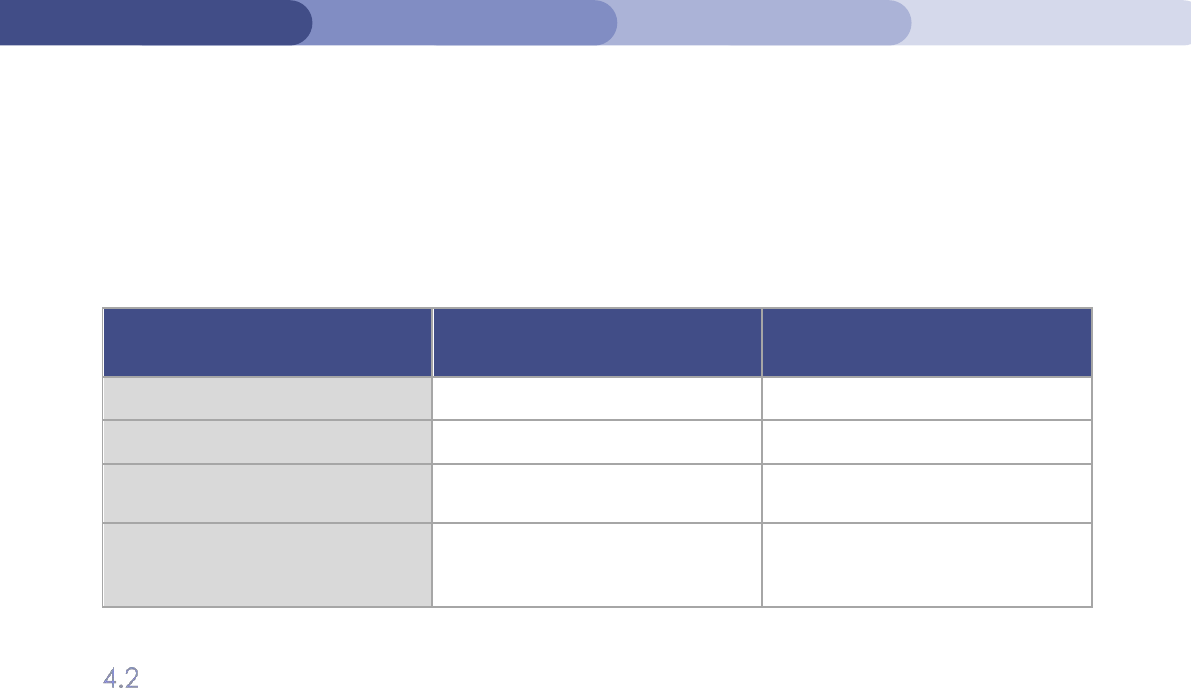
20
This investment would be comprised of blended finance from impact and commercial
investors, development finance institutions, local government agencies, the anchor
corporate partner, and local water utility.
Additional details about the assumptions used in the model are provided in Annex III.
Table 2. Summary of MWS pilot details
Results over a
6-year period
Proof of concept
(250 hectares)
Phase 1
(20,000 hectares)
Number of farmers
50
~4,000
Upfront cost of project
$1.1 million
$10 million
Water savings
(cubic meters)
5.25 million
420.3 million
Increased water availability
for water utility
(cubic meters)
3.7 million
294.2 million
REPLICATION POTENTIAL
The model aims to be replicated across Latin America. Given the FEMSA Foundation’s strong
backing for the pilot project, initial replication analysis is focused on other areas where
FEMSA operates, and which meet the below criteria. Further research is needed to localize
this review beyond the region-level, since water stress can be a hyper-local issue and the
instrument is only viable when the water-stressed areas include both agricultural and urban
users. Current replication criteria include:
• A large agricultural sector with high water usage per capita and a high percentage
of smallholder farmers
• Low levels of irrigation efficiency and the potential for increased efficiency to
generate water savings and positive environmental outcomes
• Existing or projected water stress over the next decade, and a consensus among
local policymakers that action is necessary
• The presence and identification of a clear beneficiary or group of beneficiaries, e.g.,
a local utility, water fund, and other sectoral representatives interested in improving
water conditions and potentially willing to invest or become the commercial off-
takers of a portion the water savings
• The existence of a water rights system that allows for water rights transfers between
users and does not allow for limitless extraction by an individual user

21
Based on an initial review of regions that are water-stressed and have high agricultural
output, and countries with FEMSA operations
17
, we have identified the following regions that
would be good candidates for eventual instrument replication:
• Mexico: Aguascalientes, Querétaro, Jalisco
• Brazil: Ceará, Paraíba, Pernambuco
• Argentina: La Rioja, La Pampa, Cordoba
Replication sites could also be based on the presence of one of the 25 existing water funds
in the Latin American Water Funds Partnership, which do not currently overlap with the
regions above, although there are many water funds in the development phase right now.
5. ENVIRONMENTAL AND SOCIO-ECONOMIC IMPACT
MWS will save approximately 3,500 cubic meters of water per hectare every year. For
an average smallholder farm, this is equivalent to the volume of seven Olympic-size
swimming pools
ENVIRONMENTAL IMPACT
MWS will deliver numerous environmental benefits, particularly related to reducing the water
deficit in the region and contributing to long-term water security, assuming the challenges
and risks identified are addressed.
18
With improved irrigation efficiency, farmers would save 3,500 cubic meters / hectare. For an
average farm of 5 hectares, this is equivalent to saving seven Olympic-sized swimming pools
of water every year. When expanded to 4,000 farmers across Guanajuato in Stage 1, urban
areas could gain access to up to 294 million cubic meters of water over a 6-year period,
equivalent to 117,600 Olympic-sized swimming pools of increased water availability.
While these savings are not on their own sufficient to turn around Guanajuato’s water crisis,
they will make a substantial impact in each benefitting community by contributing to a
water-secure future. As the climate changes, water scarcity will become an increasingly dire
situation for many in the region, and these savings will help the entire region become more
water efficient. Through MWS’ implementation, farmer production and income can better
adapt to the changing climate and become more resilient through increased water
availability, improved soil quality, more integrated supply chains, flooding risk management,
and potential crop diversification.
Increased water efficiency can result in reduced water extraction through diesel-powered
well pumps by farmers. Our initial estimate shows that MWS has the potential to reduce
associated carbon emissions by 92,472 metric tons each year in the 20,000 hectares pilot,
equivalent to taking 20,103 cars off the road every year.
19
17
If the initial FEMSA Foundation-led pilot succeeds, their intention is to replicate the initiative in the other Latin American
countries where FEMSA operates: Argentina, Brazil, Chile, Colombia, Costa Rica, Ecuador, Guatemala, Nicaragua, Panama,
Peru and Uruguay.
18
Unless otherwise noted, in this report these benefits are projected over six years given a one-year grace period and five-year
repayment period for the farmers’ loans.
19
Up to 0.22 kg of CO2 are emitted per cubic meter of water extracted (Scott 2013). The average car emits 4.6 metric tons of
CO2 per year (EPA).

22
In addition to modelled water savings and carbon emissions, there are additional
environmental benefits related to NBS that we have not quantified. Based on the results of
the proof of concept, these benefits will be evaluated during the Stage 1 expansion through
Guanajuato. Depending on the area, the feasibility studies conducted by MWS might
recommend NBS such as conservation agriculture, including riparian buffer strips and/or
cover crops, which could: increase water efficiency and biodiversity; improve soil quality;
provide an additional income source; mitigate the damage of flooding events on
agricultural and urban sectors; increase water infiltration (Hoorman and Sundermeier 2017);
and decrease fertilizer usage, thereby reducing pollution runoff and CO2e.
SOCIAL AND ECONOMIC IMPACT
MWS will improve economic outcomes for smallholder farmers by increasing yields, reducing
costs, increasing potential market access, and improving resilience in the face of worsening
impacts of climate change. MWS contributes to advancing the following SDGs: 6 (clean
water and sanitation), 9 (industry, innovation, and infrastructure), 12 (responsible
consumption and production), and 17 (partnerships for the goals). Additionally, through the
usage of nature-based solutions, this instrument will meet SDG 15 (life on land: protect,
restore, and promote sustainable ecosystems, sustainably manage forests).
The long-term success of MWS depends on empowering all parts of the community, and
ensuring that these communities receive meaningful benefits from water availability and
improved quality of life. Discussions with stakeholders continue to be built into project design.
WRI is leading the development of Gender and Equity guidelines for NBS projects as part of
the Cities4Forests (C4F) program
20
, which could be applied to the pilot transaction.
SECTORAL IMPACT: NATURE-BASED SOLUTIONS
The main goal of the NBS stream of the Lab is to identify innovative approaches to catalyze
private sector investment into the protection, sustainable management, and restoration of
natural or modified ecosystems. Creating a viable market for nature-based solutions
contributes to climate resilience, emissions reductions, and biodiversity benefits,
MWS’ focus on monetizing water conservation and improving soil quality through natural
approaches offers a new solution to improve the resilience of arid and semi-arid agricultural
hotspots around the world.
In Mexico, MWS will contribute to reaching the country’s adaptation objectives in its
Nationally Determined Contribution (NDC) which include: i) “The protection of communities
from adverse impacts of climate change, such as extreme hydro meteorological events
related to global changes in temperature; as well as the increment in the resilience of
strategic infrastructure and of the ecosystems that host national biodiversity;” and ii)
“guarantee food security and water access in light of growing climate threats through
integral watershed management, biodiversity and land conservation” (Seddon et al., 2019).
20
https://www.wri.org/our-work/project/cities4forests

23
NEXT STEPS
FEMSA Foundation, WRI and their partners will continue to work towards implementation of
the pilot transaction in Guanajuato and continue to address and further develop details
that remain unclear. The monetization of water savings at the utility level may take different
forms as discussed in Annex I, one of which, the pay for performance scheme, is possible but
dependent on vigorous metrics and causality links that at the moment are not yet
developed. Further legal review is required to understand the full potential for transferring
water allocations between users.
Other key aspects that require more on the ground research are i) acceptance from
farmers and water utilities, ii) reviewing the NBS options in various regions and iii) assessing
the potential of NBS beyond the farmed lands, including restoring degraded or unused
lands.
While there are several steps to take before implementing a pilot and scaling the instrument
more broadly, MWS has reached a number of milestones that demonstrate a promising path
forward. For example, the MWS team has already identified a preliminary pilot location and
enlisted the key stakeholders required for the instrument to be successful. The Lab has
confirmed the existence of significant economic, social, and environmental impacts and
laid out a pathway to scale the instrument across Latin America. The COVID-19 pandemic
has delayed the implementation and scoping timeline, but the instrument continues to be
able to address key local issues, including water scarcity, cost reductions, and risk mitigation,
and provides a path to improving economic outcomes consistent with a sustainable
recovery from this economic shock. With development funding in place, the experienced
team of WRI and FEMSA Foundation, and engaged local stakeholders, MWS is poised for
success.

24
REFERENCES
AM. Modernize Irrigation Module. July 25, 2019. At:
https://www.am.com.mx/guanajuato/noticias/MODERNIZAN-MODULO-DE-RIEGO--20190730-
0029.html.
Beverage Daily. 2018. Climate change could cause beer shortages and double prices [webpage].
Article by Rachel Artur. October 2018. At:
https://www.beveragedaily.com/Article/2018/10/16/Climate-change-could-cause-beer-shortages-
and-double-prices
CONAGUA 2018. Actualizacion de la disponibilidad media anual de agua em el acuifero Irapuato-
Valle (1119), Estado de Guanajuato. At:
https://sigagis.conagua.gob.mx/gas1/Edos_Acuiferos_18/guanajuato/DR_1119.pdf
Environmental Protection Agency. Greenhouse Gas Emissions from a Typical Passenger Vehicle. At:
https://www.epa.gov/greenvehicles/greenhouse-gas-emissions-typical-passenger-vehicle.
European Commission. 2015. Sub-región hidrológica Lerma-Chapala. Presentation by EC, RALCEA,
CODIA, AECID, FICH-UNL, LAVET. At: http://www.para-agua.net/file/ralcea/14-10-
15/Alfredo%20Marmolejo%20-%20Cuenca%20Lerma%20Chapala.pdf
Food and Agriculture Organization of the United Nations (FAO). 2020. Water management for
Climate-Smart Agriculture. At:
http://www.fao.org/climate-smart-agriculture-sourcebook/production-
resources/module-b6-water/chapter-b6-3/en/
Freshwater Trust. 2020. Compliance solutions [webpage]. At:
https://www.thefreshwatertrust.org/services/compliance-solutions/.
Guadalupe-Eligio, Filiberto & Echanove, Flavia. (2017). Mecanismos de financiamiento: caso
productores de cebada y trigo en Valle de Santiago, Guanajuato. Revista Mexicana de Ciencias
Agrícolas. 7. 1359. 10.29312/remexca.v7i6.185. At:
https://www.researchgate.net/publication/322691988_Mecanismos_de_financiamiento_caso_produc
tores_de_cebada_y_trigo_en_Valle_de_Santiago_Guanajuato
Gobierno del Estado de Guanajuato, Comision Estatal del Agua (GTO). 2015. El Agua Substerranea
en Guanajuato. At: http://agua.guanajuato.gob.mx/pdf/agua_subterranea.pdf
Gobierno de Mexico CONAGUA. AGUAS SUBTERRÁNEAS / Acuíferos. At:
https://sigagis.conagua.gob.mx/gas1/sections/Edos/guanajuato/guanajuato.html.
GTO State Water Commission (Comisión Estatal del Agua de Guanajuato). Wells and Groundwater.
At:
http://agua.guanajuato.gob.mx/disponibilidad_2.php.
Haros, B.R.; Arreguín Ramos, M., and León Andrade M. Intensidad autogestiva en los Módulos del
Distrito de Riego 011 Alto Río Lerma. Universidad de Guanajuato, Campus Celaya- Salvatierra. At:
https://redissa.files.wordpress.com/2018/04/intensidad-autogestiva-en-los-mc3b3dulos-del-distrito-de-
riego-011-alto-rc3ado-lerma.pdf
Hoogesteger, Jamie and Philippus Wester (2017). Regulation groundwater use: The challenges of
policy implementation in Guanajuago, Central Mexico. Enviornmental Science and Policy. 77. At:
https://www.sciencedirect.com/science/article/pii/S1462901117303982
Hoorman, James and Alan Sundermeien (2017). Using Cover Crops to Improve Soil and Water Quality.
At: https://ohioline.osu.edu/factsheet/anr-57
International Maize and Wheat Improvement Center (CIMMYT). 2020. What is conservation agriculture? [webpage]. At:
https://www.cimmyt.org/news/what-is-conservation-agriculture/
International Union for Conservation of Nature (IUCN). 2020. Nature-based Solutions [webpage]. At:
https://www.iucn.org/commissions/commission-ecosystem-management/our-work/nature-based-solutions

25
JAPAMI 2018. Plan de trabajo 2016-2018. At:
https://www.japami.gob.mx/transparencia/LGT/30_Estadisticas/2018/SOPORTE/Plan%20de%20Trabajo%202016-2018.pdf
Löffler-Dauth, Ludwig Maria. 2017. Drip-irrigation use in Northern Guanajuato, Mexico. An evaluation in the broccoli production
sector. MSc. Thesis by Ludwig Maria Löffler-Dauth, July 2017, Water Resources Management group at Wageningen University.
At: https://edepot.wur.nl/419392
Lopez-Morales, Carlos 2011. Policies and Technologies for a Sustainable Use of Water in Mexico: A
Scenario Analysis. At: https://www.tandfonline.com/doi/abs/10.1080/09535314.2011.635138
Maranon, Boris 2000. La gestion del agua subterranea em Guanajuato. La experiencia de las COTAS.
At:
http://www.pa.gob.mx/publica/cd_estudios/Paginas/autores/mara%F1on%20boris%20la%20gestion%
20del%20agua%20subterranea.pdf
National Water Commission of Mexico (CONAGUA). 2017. Statistics on Water in Mexico., 2017 Edition.
National Water Commission. At: http://sina.conagua.gob.mx/publicaciones/EAM_i_2017.pdf
National Water Commission of Mexico (CONAGUA). 2018. Actualizacion de la Disponibilidad Media
Anual de Agua en el acuifero Irapuato-Valle (1119), Estado de Guanajuato. January 2018. At:
https://sigagis.conagua.gob.mx/gas1/Edos_Acuiferos_18/guanajuato/DR_1119.pdf
Organization for Economic Cooperation and Development (OECD). 2020. Water and Agriculture
[webpage]. Paris. At:
https://www.oecd.org/agriculture/topics/water-and-agriculture/
Quantified Ventures. Case Study DC Water. Case Study by Quantified Ventures. At:
https://static1.squarespace.com/static/5d5b210885b4ce0001663c25/t/5e136b61f2afef61e95e7472/15
78331001269/DC+Water+Case+Study_Quantified+Ventures.
Quantified Ventures. About the Soil and Water Outcomes Fund. At:
https://static1.squarespace.com/static/5db70c3d3a013f252a36f1da/t/5f18567558182f1d752ebb6c/1595430535186/SWOF+Infor
mational+One+Sheet
Scott, Christopher. (2013). Electricity for groundwater use: constraints and opportunities for adaptive response to climate
change. Environmental Research Letters. At: https://iopscience.iop.org/article/10.1088/1748-9326/8/3/035005/pdf
Seddon, N., Sengupta, S., García-Espinosa, M., Hauler, I., Herr, D. and Rizvi, A.R. (2019). Nature-based Solutions in Nationally
Determined Contributions: Synthesis and recommendations for enhancing climate ambition and action by 2020. Gland,SDAYR-
GTO (Secretaria de Desarrollo Agroalimentario y Rural, Estado de Guanajuato) (2013). At:
http://strc.guanajuato.gob.mx/templates/COMUNICACION/LIBROSBLANCOS/SDA/LB_SDA_SOC_Tecnificaci%C3%B3n%20del%2
0riego%20con%20agua%20subterranea_4.pdf
SIAP (Servicio de Informacion Agropequaria y Pesquera). 2018. Estadistica de uso tecnologico y de servicios em la superficie
2018: Riego. At:
https://www.gob.mx/siap/acciones-y-programas/produccion-agricola-33119
Switzerland and Oxford, UK: IUCN and University of Oxford. At: https://portals.iucn.org/library/sites/library/files/documents/2019-
030-En.pdf
The Nature Conservancy. 2017. Groundwater Recharge in the Saginaw Bay Watershed. March 1, 2017. At:
https://www.conservationgateway.org/ConservationByGeography/NorthAmerica/UnitedStates/michigan/projects/Documents
/GWR%20PfP%20fact%20sheet_3_1_17.pdf.
The Nature Conservancy. 2019. Brandywine-Christina Revolving Water Fund [webpage]. June 5, 2019. At:
https://www.nature.org/en-us/about-us/where-we-work/united-states/delaware/stories-in-delaware/brandywine-christina-
revolving-water-fund/
United States Geological Survey (USGS). 2020. Irrigation Methods: Furrow or Flood Irrigation
[webpage]. At: https://www.usgs.gov/special-topic/water-science-school/science/irrigation-
methods-furrow-or-flood-irrigation?qt-science_center_objects=0#qt-science_center_objects
World Resources Institute (WRI), 2020. Aqueduct Country Rankings. At:
https://www.wri.org/applications/aqueduct/country-rankings/?country=MEX&indicator=bws
World Bank; CIAT; CATIE. 2014. Climate-Smart Agriculture in Mexico. CSA Country Profiles for Latin
America. Series. Washington D.C.: The World Bank Group. At:
https://assets.publishing.service.gov.uk/media/57a089dde5274a31e00002da/CSA-in-Mexico.pdf

26
ANNEX I: SCENARIOS REGARDING WATER AVAILABILITY AND
SOURCES
Depending on the regional regulations and geography, there are a variety of potential
scenarios that MWS could face. Each scenario comes with distinct opportunities and
challenges, and the structure of the instrument will need to accommodate these
differences.
1. Urban centers and farmers rely on different water sources; urban center water source
is at a deficit, and the farmers’ source is stable or at a surplus. The savings from the
farmers can be transferred to the urban center. Investments in new infrastructure are
required to achieve the actual transference. The types of infrastructure and
investments needed will vary depending on the geographic and territorial
characteristics of the systems. For example, if the urban center requires water of a
different quality than the farmers, then investments in treatment systems will need to
be made. This scenario is the case in the La Purisima district that is being evaluated
for the proof of concept.
2. Urban centers and farmers rely on a common source, which is at a deficit. In this
situation, the water transference from farmers to utilities should not be promoted as
this would continue to exacerbate water scarcity. Instead, the SPV could aim to
generate revenue from a conservation fee. In this case, a public beneficiary could
pay for the water savings to remain unused in the aquifer, such that over-extraction is
reduced and the deficit is reversed. The types of beneficiaries that may be
candidates for this type of model are those that are willing to subsidize or pay for
deficit reversal, such as the federal government, a state or local government, a water
fund, or even urban users through a tariff. Further research and development would
be needed to determine the specifics of how this would work, who could be
interested in paying for and funding it, and how local policies affect the payments. If
feasible, this scenario could still meet MWS’ water security goals and provide
economic surplus for the region.
3. Urban centers and farmers rely on different sources; farmers’ source is at a deficit and
the urban center’s source is stable or at a surplus. The applicable model is similar to
#2. MWS should create incentives and charge a water conservation fee as opposed
to transferring water volume. Water savings are higher in this scenario since none or
little of the savings are used by other users, resulting in a higher impact of sustainable
agriculture and NBS.
4. Urban centers and farmers rely on a common source, which is stable or at a surplus.
The farmers’ water savings can be virtually transferred to the urban centers, with less
infrastructure likely required than in #1, although there could be fewer incentives for
water utilities to be interested in the instrument in this scenario.
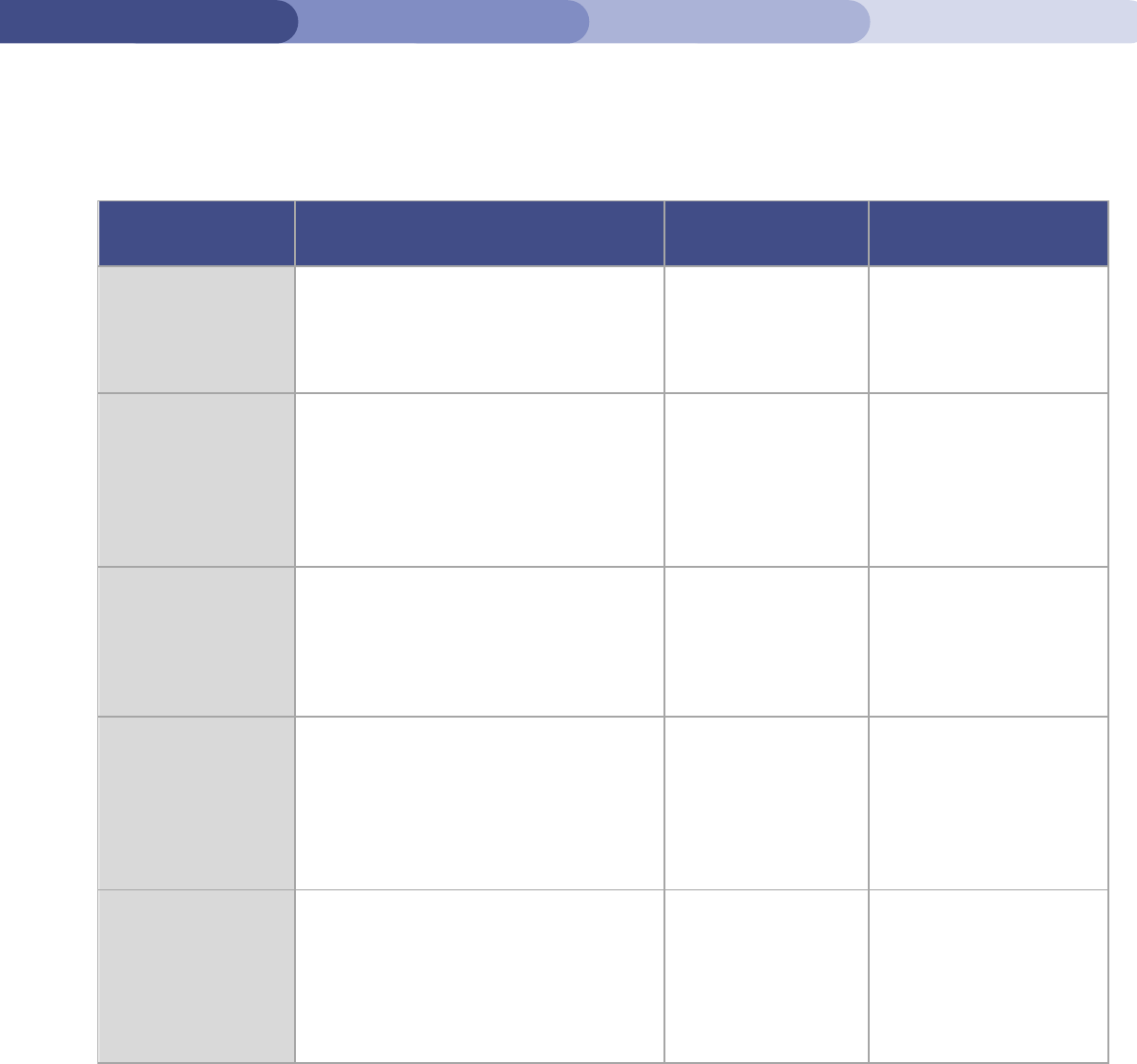
27
ANNEX II: EXAMPLES OF COMPARABLE INSTRUMENTS
Instrument
Attributes
Geography
/ sector
How MWS is
different
Brandywine-
Christina
Revolving
Water Fund
Fund pays for green infrastructure
to reduce water pollution, city
repays costs after regulatory
approval (TNC, 2019)
NBS in Delaware
Focused on water
scarcity, not
pollution; multiple
beneficiaries and
revenue streams
DC Water
Environmental
Impact Bond
Investors fund green infrastructure
to avoid $2 billion investment by
DC Water, utility pays back over
time with option for higher
repayment based on project
success (Quantified Ventures, DC
Water)
Stormwater
runoff
infrastructure in
Washington D.C.
Water savings
monetized by utility;
implementation is at
the farmer level
Freshwater Trust
Trust implements NBS near rivers;
sells benefits of improved water
quality and reduced pollution to
corporations and governments
seeking regulatory compliance
(Freshwater Trust, 2020)
River
management in
Western U.S.
Implementation is at
the farmer level;
focus on water
scarcity as well as
quality
Saginaw Bay
Watershed
Groundwater
Recharge Pay-
for-
Performance
Pays farmers to implement
conservation practices and NBS;
payments are based on quantity
of implementations and modelled
expected groundwater recharge
(TNC, 2017)
Sustainable
agriculture in the
U.S. Midwest
Farmers are
aggregated into
cooperative for
additional benefits;
inclusion of utility
and corporate
beneficiaries
Soil and Water
Outcomes Fund
Fund provides capital to farmers
to implement best management
practices; beneficiaries (cities,
utilities, corporations) pay for
verified environmental outcomes
(Quantified Ventures, Soil and
Outcomes Fund)
Sustainable
agriculture in the
U.S. Midwest
Corporation has
additional benefits
of simplified /
integrated supply
chain

28
ANNEX III: FINANCIAL MODELLING DETAILS
Geography: While the final pilot location is still being evaluated, and selection will depend
on the results of feasibility analyses, for the purpose of this report and modelling, the pilot
transaction area selected is in Module 11 (La Purisima) of Guanajuato’s Irrigation District 11,
which comprises about 5,000 hectares and is located just outside Irapuato (Haros et al 2018).
Monetization of water savings: Investments to transfer and treat water from the La Purisima
dam to Irapuato are not currently included in the instrument costs and for our model are
assumed to be made by the water utility or another public entity (e.g. state or federal
government). Even if this capital investment is delayed or does not take place for the proof
of concept, the proof of concept could still provide excess economic value from the
increase in farmer revenues and benefits to the corporate partner. Depending on the
scenarios discussed in Annex I, in future replications, utilities may need smaller investments to
secure the water savings or the payments might be structured instead as conservation fees
with no water allocation transfers. Based on the details of these scenarios, the instrument
could generate short-term cost savings for utilities as well as water benefits.
Assumptions: The model has three aspects: farmer income, water flow, and fund
performance. The farmer income calculation is: net income of two crop rotations, including
a summer and winter crop (in our model assumed to be corn and barley), an infusion of
upfront capital to purchase and install an irrigation and seeding system, and then
repayments of that capital over a 5-year period, starting after a one-year grace period. The
water system benefits calculation is estimated for the proof of concept project, since the
main benefit to Irapuato is an alternative source of water and not necessarily lower costs of
water acquisition. In future replications, however, the water benefit will ideally involve the
avoided cost of groundwater extraction and treatment for farmers and the urban center.
Other key modeling assumptions include:
• 20% of the instrument cost is for technical assistance, and 80% is allocated to the
provision of loans. A small amount is additionally allocated to the fund’s operating
expenses. Technical assistance provide training on i) how to use the drip irrigation
systems, ii) how to implement conservation practices, and iii) additional ongoing
support related to project financing.
• A farmer repayment rate of 95%
• Technification loans:
o 50% of the system financing is a loan with 12% interest, re-paid semi-annually
over five years
o 40% of the system financing is an interest-free subsidized loan, re-paid annually
over five years
o 10% of the system financing is a farmer downpayment
• For each irrigation system: upfront purchase cost of $2,500, installation cost of $1,250,
and direct seeder cost of $42. Bi-yearly maintenance charges of $625 are assumed to
be covered by the technical assistance arm of the SPV
• Crop switching scenarios (which may be recommended to some farmers) are not
modeled, since the fund outcomes are not dependent on this portion of the
implementation
• All farmer benefits are due to increased yields, and we did not model any of the
numerous other potential farmer benefits, including:
o Cost decreases due to the installation of the fertilizer system
o Shares in the SPV and corresponding dividends

29
o Access to a secure long-term buyer
o Direct payments for water savings
Results: The model projects annual water savings of 3,503 cubic meters per hectare per
year. Over six years, which is how long it will take for farmers to pay off their loans, this
equates to roughly 5.25 million cubic meters in the 250-hectare pilot project and 420 million
cubic meters in Stage 1 across Guanajuato (20,000 hectares). After accounting for a 30%
efficiency loss of transporting and treating the water before it is used by a water utility, the
pilot area would increase availability for urban users by 294 million cubic meters over six
years. This could help fully offset Irapuato’s annual groundwater extractions and potentially
reduce the aquifer’s annual deficit by 60%.
21
These savings would reduce the 1 billion cubic
meter aquifer deficit for all of Guanajuato by 5% annually (CEAG, 2020). While this number is
small relative to the dire situation in Guanajuato, the gains would be highly localized and
significant in regaining the hydrological balance of specific aquifers that are currently being
overexploited and at risk of depletion. Therefore, MWS has the potential to contribute to the
long-term ecological health of multiple aquifers and thus, to provide water to areas that
would not otherwise have a secure water future.
21
Irapuato’s annual water deficit is 71.5 million cubic meters per year (CONAGUA 2018). Irapuatuo’s current annual
groundwater extractions are approximately 42.5 million cubic meters of water (JAPAMI 2018).
